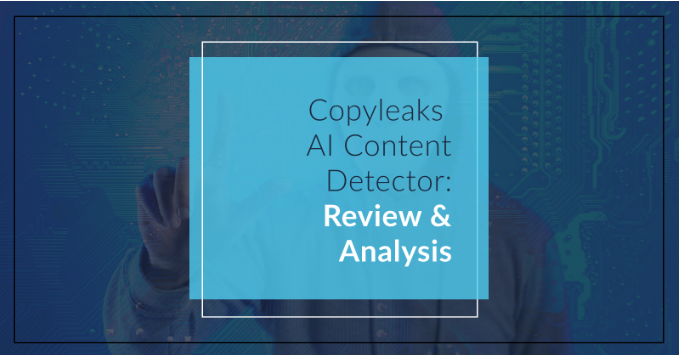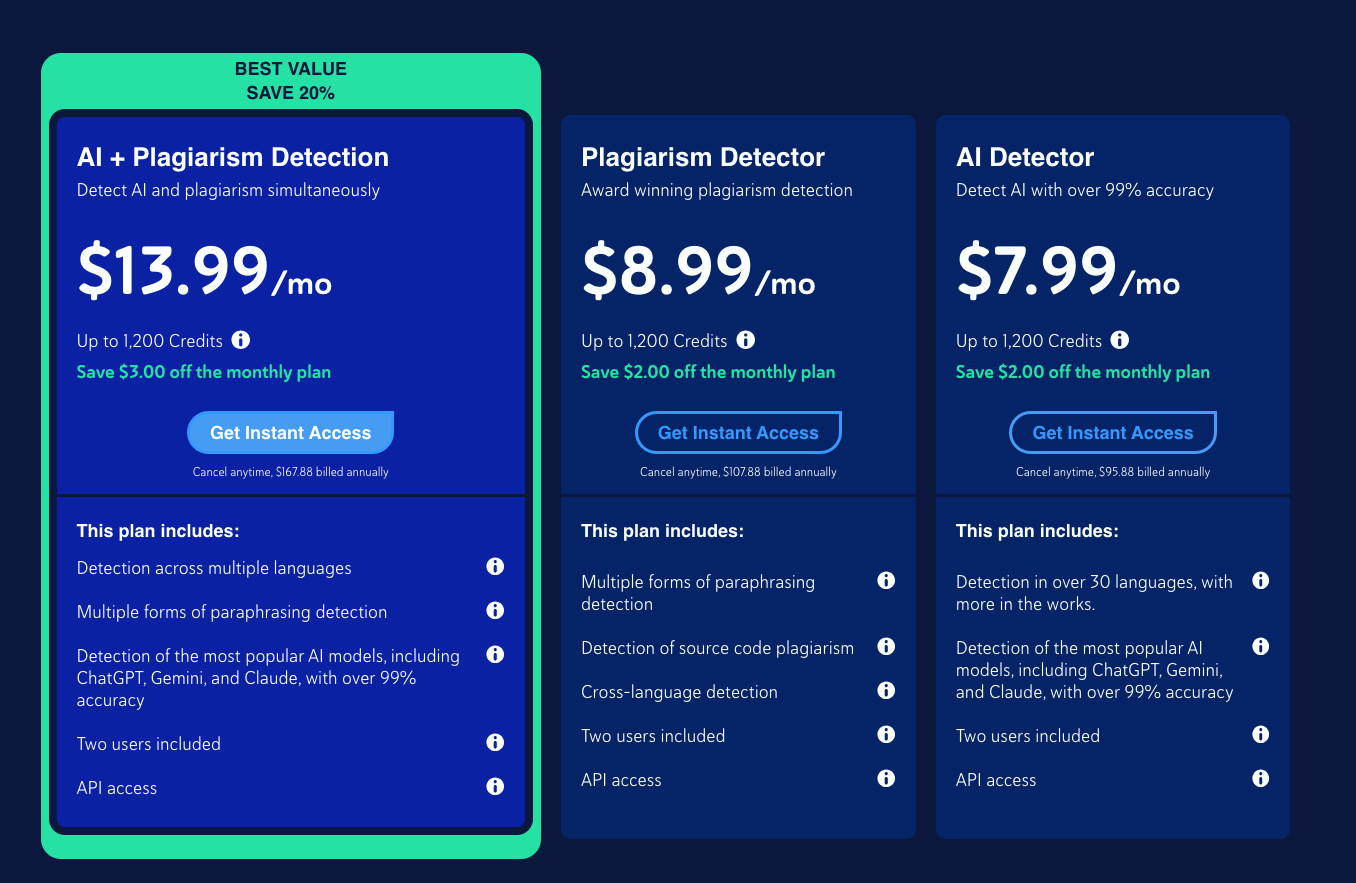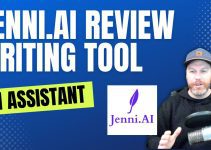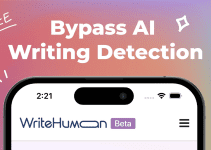
In today’s digital landscape, where AI-powered content generation is rapidly transforming how we create and consume information, the need for tools that ensure originality and authenticity has never been greater. But have you ever wondered, Is your content truly original, or is it a product of AI-generated text?
Enter Copyleaks AI Content Detector, a comprehensive suite of products designed to help you navigate the complexities of content originality in the age of artificial intelligence. Trusted by institutions and enterprises worldwide, Copyleaks offers a powerful solution for detecting AI-generated text, safeguarding the integrity of your work, and maintaining the trust of your audience.
Key Takeaways
- Copyleaks AI Content Detector is a robust platform for detecting AI-generated content and ensuring originality.
- Copyleaks serves over 1,000 institutions and 300+ enterprises, establishing responsible AI adoption and content integrity.
- Copyleaks offers both a Plagiarism Checker API and an AI Content Detection API to comprehensively address content originality concerns.
- With over 30 million scans per month, Copyleaks is trusted by customers in more than 100 countries to maintain high standards of content quality.
- Copyleaks’ AI-powered detection capabilities provide a reliable solution for identifying and preventing the use of AI-generated text.
What is Copyleaks AI Content Detector?
The Copyleaks AI Content Detector is a powerful suite of products designed to help organizations and individuals detect AI-generated content and ensure content originality. This cutting-edge solution is trusted by institutions and enterprises worldwide, processing over 30 million scans per month for AI content and plagiarism detection across more than 100 countries.
A Suite of Powerful Products
The Copyleaks AI Content Detector boasts an impressive accuracy of over 99%, which is significantly higher than any other AI detector in the market. Its advanced algorithms can detect various AI models, including ChatGPT, Gemini, Claude, Jasper 3, and T5, with each model having a detection accuracy above 98.0%. The chance of falsely labeling human-generated content as AI content is as low as 0.2%, the lowest among AI detection platforms.
The Copyleaks AI Content Detector offers versatile applications, including browser extensions, API integrations, and a user-friendly web platform. Its comprehensive suite of tools empowers users to safeguard the authenticity of their content, ensuring it aligns with their brand and values.

Trusted by Institutions and Enterprises Worldwide
The Copyleaks AI Content Detector has earned the trust of a wide range of institutions and enterprises across the globe. Its exceptional performance and reliability have made it the go-to solution for organizations seeking to maintain the integrity of their content in the face of the growing challenge of AI-generated content.
Independent studies have consistently confirmed the accuracy and efficiency of the Copyleaks AI Content Detector, positioning it as the most reliable tool for detecting AI-generated content from Large Language Models (LLMs). With its unwavering commitment to quality and innovation, Copyleaks continues to lead the way in the battle against the threat of AI-generated content.
The Downsides of AI-Generated Content
The rapid rise of AI-powered tools like ChatGPT has undoubtedly revolutionized content creation. However, this technological advancement also brings significant risks that organizations must address. One of the primary concerns is the potential for AI-generated content to contain misinformation and factual errors. With the ease of producing text, images, and even multimedia without the need for thorough research, the quality and accuracy of the output can be severely compromised.
Moreover, the ease of generating content through AI can have a detrimental impact on the quality of education. When students or researchers rely heavily on AI-generated materials instead of engaging in the research and writing process, it can undermine the very purpose of education – to develop critical thinking, analytical skills, and a deep understanding of the subject matter.
- According to AI expert Soheil Feizi of the University of Maryland, “Current detectors of AI aren’t reliable in practical scenarios.”
- The European Union’s Digital Services Act (DSA) threatens fines of up to 6 percent of global revenue for violators who do not adhere to increased monitoring requirements on digital platforms, including for deepfake content.
- Proposed legislation in California aims to mandate watermarking for any content produced by AI models as a preventive measure against misuse.
Addressing these challenges requires a multifaceted approach, as organizations must implement robust measures to ensure the authenticity and quality of the content they rely on. By taking proactive steps to detect and mitigate the risks of AI-generated content, institutions can maintain the integrity of their programs and uphold the standards of education and research.
| AI Content Generation Tools | AI Content Detection Tools |
|---|---|
| ChatGPT, Jasper, Copy.ai | Originality AI, Content at Scale, Copyleaks |
How to Avoid and Detect AI-Generated Content
In the face of the growing influence of AI-powered content generation, it’s crucial for organizations to have strategies in place to avoid and detect AI-generated content. By employing a multi-pronged approach, you can maintain the integrity and authenticity of your content, ensuring it aligns with your brand’s standards and meets the expectations of your audience.
One essential step is to utilize AI content detection tools, such as Copyleaks AI Content Detector. Copyleaks offers impressive accuracy, with a 99.1% detection rate and a low 0.2% false positive rate. It can effectively identify AI-generated source code, including content from ChatGPT and GitHub Copilot, as well as text from various AI models like ChatGPT and Bard. By leveraging these advanced detection capabilities, you can confidently maintain the originality and trustworthiness of your content.
Additionally, it’s vital to communicate your content originality standards upfront and set clear expectations for your contributors. This helps ensure that everyone involved in the content creation process is aligned with your organization’s values and requirements, reducing the likelihood of AI-generated content slipping through.
| Strategy | Key Benefits |
|---|---|
| Utilize AI Content Detection Tools |
|
| Communicate Content Originality Standards |
|
By implementing these strategies, you can effectively detect ai-generated content and avoid ai-generated content, ensuring your content remains authentic, engaging, and valuable for your audience.
Employ an AI Content Detection Tool Like copyleaks ai content detector
In the era of AI-generated content, utilizing a reliable AI content detection tool is crucial for maintaining the integrity and authenticity of your written material. Tools like Copyleaks AI Content Detector offer a powerful solution to this challenge, providing you with the ability to scan submitted content for any signs of AI-generated text.
Copyleaks, for example, offers a free AI content detector that can quickly analyze your content and provide detailed insights on its authenticity. This tool leverages cutting-edge machine learning models to deliver exceptional accuracy in identifying AI-generated text, ensuring that your work remains genuine and original.
The benefits of using an AI content detection tool like Copyleaks are numerous:
- High Accuracy Detection: Copyleaks’ AI-powered technology provides unparalleled accuracy in identifying AI-generated content, maintaining the integrity of your work.
- Real-Time Analysis: Copyleaks offers immediate results, making it ideal for professionals who need to quickly verify the authenticity of their content.
- Free Access: Copyleaks provides core functionalities at no cost, ensuring accessibility for users of all backgrounds.
- Comprehensive Reports: The tool generates detailed reports outlining the likelihood of AI-generated content, empowering you to make informed decisions.
By incorporating an AI content detection tool like Copyleaks into your writing process, you can confidently maintain the originality and credibility of your work, whether in academic, professional, or business settings. This not only safeguards your reputation but also upholds the standards of quality and authenticity that your audience expects.
| AI Content Detection Tool | Accuracy in Detecting AI-Generated Content | Plagiarism Checking Capabilities | Ease of Use |
|---|---|---|---|
| Copyleaks AI Content Detector | 99% accurate in identifying AI-generated content | Powerful plagiarism checking, detecting 100% of plagiarized content in test samples | Intuitive interface, requires no technical expertise |
| Originality.AI | 90% accurate in detecting AI-written content, struggled with human-written content | Comprehensive plagiarism detection, identifying 100% of plagiarized samples | User-friendly, but limited free trial options |
| Content at Scale | 85% accuracy claim, assessed AI-generated text as 31% human-written | Plagiarism checking capabilities, but lacked sentence-level highlighting | Straightforward interface, but limited free access |
In conclusion, incorporating an AI content detection tool like Copyleaks AI Content Detector into your writing process is a crucial step in ensuring the authenticity and originality of your generated content. By leveraging the power of cutting-edge technology, you can maintain the integrity of your work and uphold the standards of quality that your audience expects.
Communicate Content Originality Standards Upfront
In addition to leveraging AI content detection tools, it’s crucial to set clear expectations with participants from the outset. Organizations should be transparent about their stance on ai-generated content and make it unequivocal that such content is not permitted. By communicating these content originality standards upfront, you can effectively discourage any attempts to submit non-original work.
Set Clear Expectations
Establishing a comprehensive ai-generated content policy and sharing it with all participants is a vital step. This policy should outline the organization’s commitment to maintaining the integrity of the submission process and the consequences for submitting ai-generated content. By setting these clear expectations, you can ensure that all participants understand the importance of original and authentic content.
- Clearly communicate your stance on ai-generated content and the reasons behind it.
- Outline the specific guidelines and requirements for submitting original content.
- Explain the consequences for participants who submit non-original work, such as disqualification or exclusion from future programs.
- Encourage participants to review and familiarize themselves with the content originality standards before submitting their entries.
By taking a proactive approach and establishing transparent content originality standards, you can foster a culture of authenticity and discourage the use of ai-generated content in your submission programs.
Create an Eligibility Screening Process
Implementing an effective eligibility screening process is a crucial step in ensuring the integrity of your application review process. By filtering out ineligible submissions early on, you can save valuable time and resources, allowing your team to focus on evaluating the most promising candidates.
The application review process typically involves several stages, and an eligibility screening at the beginning can make a significant difference. This screening can involve collecting specific details from applicants and using automated scoring to assess their eligibility based on predefined criteria. By taking this approach, you can quickly identify and remove submissions that do not meet your requirements, streamlining the overall review process.
- Establish Clear Eligibility Criteria: Clearly define the eligibility requirements for your program or contest. This may include factors such as academic qualifications, work experience, demographic information, or specific skills and achievements.
- Implement an Automated Scoring System: Develop an automated scoring system that can assess applicant information against your eligibility criteria. This can help you quickly identify and separate eligible submissions from those that do not meet the requirements.
- Collect Relevant Information: Ensure that your application form or submission process collects all the necessary information to determine eligibility. This may include educational background, employment history, portfolio samples, or other relevant data points.
- Review and Refine the Process: Regularly review your eligibility screening process and make adjustments as needed. Monitor the effectiveness of your criteria and scoring system, and be prepared to update them to accommodate changing requirements or new applicant profiles.
By implementing a robust eligibility screening process, you can streamline your application review process and focus your efforts on evaluating the most qualified and eligible submissions. This can lead to a more efficient and effective selection process, ultimately helping you identify the best candidates for your program or contest.
Require Diverse Submission Formats
To discourage the use of AI-generated content, organizations should require submissions to include more than just text. Incorporating multimedia elements, such as videos, visuals, and artwork, can help diversify the content and make it harder for participants to rely solely on AI-generated text. This approach also encourages a more well-rounded and authentic submission process.
Multimedia and Visual Elements
By requiring a variety of submission formats, you can ensure that the content is not solely reliant on AI-generated text. Encourage participants to include multimedia elements, such as:
- Videos: Participants can submit short video overviews or demonstrations of their work.
- Visuals: Infographics, illustrations, or photographs can help showcase the visual aspects of the submission.
- Artwork: Participants can include original artwork, such as paintings, sketches, or digital designs, to complement their written content.
These diverse submission formats not only make it more challenging for AI-generated content to be used, but they also enhance the overall quality and authenticity of the submissions. By embracing multimedia and visual elements, you can create a more engaging and well-rounded experience for both the participants and the reviewers.
| Submission Format | Benefits |
|---|---|
| Videos | Showcase the participant’s work in an engaging and dynamic format, making it harder to rely solely on AI-generated text. |
| Visuals | Enhance the overall presentation and appeal of the submission, providing a more holistic representation of the participant’s work. |
| Artwork | Demonstrate the participant’s creative abilities and add a unique, personal touch to the submission. |
By requiring diverse submission formats, you can encourage participants to showcase their skills, knowledge, and creativity in a more well-rounded manner, ultimately discouraging the use of AI-generated content and promoting genuine, original submissions.
Implement a Multi-Stage Review Process
When dealing with complex or time-consuming submission programs, a multi-stage review process can be a game-changer. By implementing integrity checks at multiple stages of the review process, organizations can ensure that submissions are thoroughly evaluated and any potential issues are identified early on. This could involve, for example, requiring sign-off from an advisor or manager before a submission is considered for final review.
Integrity Checks at Multiple Stages
The key to a successful multi-stage review process lies in the implementation of comprehensive integrity checks. These checks should be conducted at each stage of the review, from the initial application to the final evaluation. This approach helps to maintain the highest standards of quality and originality, while also identifying any potential concerns or discrepancies early in the process.
- Initial Application Review: During the first stage, submissions should undergo a thorough review to assess their basic eligibility, format, and compliance with established guidelines.
- Advisor/Manager Sign-off: Before a submission is considered for final review, it should be reviewed and approved by an advisor or manager to ensure it meets the required standards.
- Final Evaluation: The last stage of the review process should involve a comprehensive evaluation, including the use of AI content detection tools like Copyleaks, to verify the originality and integrity of the submitted content.
By implementing this multi-stage review process with integrity checks at each stage, organizations can significantly improve the quality and authenticity of the submissions they receive, ultimately enhancing the overall credibility and integrity of their programs.
| Stage | Purpose | Integrity Checks |
|---|---|---|
| Initial Application Review | Assess eligibility, format, and compliance with guidelines | Verify basic format, content, and adherence to submission requirements |
| Advisor/Manager Sign-off | Ensure submissions meet required standards | Review for quality, originality, and alignment with program goals |
| Final Evaluation | Comprehensive review, including AI content detection | Employ Copyleaks AI Content Detector to verify originality and integrity |
By incorporating these multi-stage integrity checks, organizations can significantly enhance the quality and authenticity of the submissions they receive, ultimately strengthening the credibility and integrity of their programs.
Reinforce Original Content Requirements
Throughout the submission process, it’s crucial to reinforce your organization’s stance on original content. This can be achieved by creating and clearly communicating a comprehensive policy on AI-generated content and the consequences of submitting non-original work. By consistently reminding participants of these requirements, you can further discourage the use of AI-generated content and promote the creation of truly original work.
One effective strategy is to incorporate reminders about your original content policy at multiple touchpoints during the submission process. This could include prominently displaying the policy on your website, including it in all submission guidelines and instructions, and reiterating the requirements in email communications with participants.
- Clearly define what constitutes original content in your policy, emphasizing that the use of AI-generated text or content is strictly prohibited.
- Outline the consequences of submitting non-original work, such as disqualification from the submission process or potential legal action.
- Provide resources and guidance on how participants can ensure their content is original, including the use of AI content detection tools like Copyleaks.
By taking a proactive and consistent approach to reinforcing your original content requirements, you can foster a culture of integrity and authenticity within your organization, ultimately leading to the submission of high-quality, original work that meets your standards.
| AI Content Detection Tool | Key Features | Accuracy Rate |
|---|---|---|
| Copyleaks |
|
99% accuracy |
| BypassGPT |
|
100% unique output |
“By consistently reminding participants of your original content requirements, you can further discourage the use of AI-generated content and promote the creation of truly original work.”
Understand the Power of AI Content Generation
As the world grapples with the challenges posed by AI-generated content, it’s crucial to understand the true power of these advanced tools. Platforms like ChatGPT have showcased the remarkable capabilities of AI in content generation, blurring the lines between human-written and machine-generated text.
Machine learning and deep learning algorithms are at the heart of automated content detection, enabling sophisticated techniques to differentiate between content created by humans and machines. Stylometric features, such as vocabulary richness, sentence complexity, and readability, are analyzed by AI detectors to identify the unique fingerprints of algorithmic versus human writing. These classifiers learn to spot the nuances that set AI-generated content apart, continuously adapting to the evolving sophistication of AI writing tools.
Cutting-edge AI content detectors like Copyleaks AI have demonstrated exceptional accuracy in identifying AI-generated and plagiarized content, with accuracy rates of over 98%. These tools leverage advanced algorithms, such as N-grams, syntax analysis, and lexical analysis, to understand context, examine word arrangement, and assess lexical components for authorship attribution.
The integration of AI content detection has become crucial across various sectors, from education to e-commerce, where maintaining the integrity of submissions and reviews is paramount. In academia, nearly 70% of educators now utilize AI tools to verify the originality of student work, safeguarding the quality and credibility of educational outcomes.
While the power of AI content generation continues to evolve, human ingenuity and creativity remain the driving force behind authentic, high-quality content. By understanding the capabilities and limitations of these AI tools, organizations can develop robust strategies to maintain the integrity of their submission programs and ensure the authenticity of the content they publish.
Conclusion
As the rise of AI-generated content poses a growing challenge for organizations relying on quality submissions, it’s crucial to employ a comprehensive approach to mitigate the risks and maintain the integrity of your programs. By employing an AI content detection tool like Copyleaks AI Content Detector, you can effectively identify and eliminate AI-generated content, ensuring the originality and credibility of your submissions.
Alongside leveraging AI detection tools, it’s essential to communicate your expectations for content originality upfront, establish a robust eligibility screening process, and implement a multi-stage review process. This holistic approach will empower you to stay ahead of the evolving landscape of AI-generated content and safeguard the authenticity and value of your programs.
Staying informed on the latest advancements in AI writing tools, such as ChatGPT, will help you anticipate and adapt to the rapidly changing landscape. By embracing a proactive and vigilant mindset, you can navigate the challenges posed by AI-generated content and maintain your competitive edge by promoting genuine, high-quality submissions that deliver genuine value to your audience.
FAQ
What is Copyleaks AI Content Detector?
How accurate is Copyleaks AI Content Detector?
What are the downsides of AI-generated content?
How can organizations avoid and detect AI-generated content?
How can Copyleaks AI Content Detector help?
How can organizations communicate content originality standards?
What is an eligibility screening process?
Why should organizations require diverse submission formats?
What is a multi-stage review process?
How can organizations reinforce original content requirements?
How can organizations understand the power of AI content generation?
Source Links
- Should Companies Use AI in Customer Service? – Copyleaks – https://copyleaks.com/blog/how-can-ai-help-you-today-genai-in-customer-support
- Detecting AiGeneratedText with CopyLeaks API doesn’t return AI detection results in the final report – https://stackoverflow.com/questions/75201709/detecting-aigeneratedtext-with-copyleaks-api-doesnt-return-ai-detection-results
- 7 Best AI Content Detector Tools – https://www.bitrix24.com/articles/7-best-ai-content-detector-tools.php
- PDF – https://copyleaks.com/wp-content/uploads/2023/05/ai-content-detector-faqs.pdf
- Copyleaks AI Content Detection Review – Originality.AI – https://originality.ai/blog/copyleaks-ai-content-detection-review
- AI Content Detector – Copyleaks – https://chromewebstore.google.com/detail/ai-content-detector-copyl/gplcmncpklkdjiccbknjjkoidpgkcakd
- How Reliable Are AI Detectors? Claims vs. Reality – https://www.theblogsmith.com/blog/how-reliable-are-ai-detectors/
- The Race to Detect AI-Generated Content and Tackle Harms | TechPolicy.Press – https://techpolicy.press/the-race-to-detect-aigenerated-content-and-tackle-harms
- A well-rounded approach to avoid and detect AI-generated content in your applications – https://goodgrants.com/resources/articles/a-well-rounded-approach-to-avoid-and-detect-ai-generated-content-in-your-applications/
- Copyleaks AI Detection Review & How to Bypass it – StealthWriter blog – https://blog.stealthwriter.ai/analyzing-and-bypassing-copyleaks-ai-in-2023/
- How to Bypass Copyleaks AI Detection – An All-Inclusive Guide – https://www.linkedin.com/pulse/how-bypass-copyleaks-ai-detection-all-inclusive-guide-anna-yuliani-vuasc
- How to Bypass Copyleaks AI Detection: 6 Tricks That Work – https://medium.com/@JoeyGeller/how-to-bypass-copyleaks-ai-detection-6-tricks-that-work-61784f42dd5d
- Best AI Content Detectors for 2024 – https://medium.com/@artturi-jalli/best-ai-content-detectors-for-2024-2cbdf4760a3e
- Do AI Detectors Really Work? I Put Them To Test – https://www.jeffbullas.com/ai-detector/
- AI Detector | Identify AI generated content for free – https://www.hirequotient.com/ai-detector
- A holistic approach to avoid and detect AI-generated content in your submissions program – https://awardforce.com/blog/articles/a-holistic-approach-to-avoid-and-detect-ai-generated-content-in-your-submissions-program/
- The Best AI Detection Tools of 2023—Or, When the Turing Test Just Won’t Cut It – https://www.verblio.com/blog/ai-detection-tools
- Grammarly and AI Detection – https://www.linkedin.com/pulse/grammarly-ai-detection-dr-diane-hamilton-cx3nc
- How to identify resumes created by AI or ChatGPT | Michael Page – https://www.michaelpage.com.tw/advice/management-advice/hiring/how-identify-resumes-created-ai-or-chatgpt
- Comparing AI Detection Tools: One Instructor’s Experience | The Institute for Learning and Teaching – https://tilt.colostate.edu/comparing-ai-detection-tools-one-instructors-experience/
- The top seven AI detectors of 2024 (free and paid) – https://www.independent.co.uk/tech/ai-content-detection-tools-comparison-expert-insights-b2557071.html
- The Do’s and Don’ts You Need To Know Before Utilizing AI Detectors – Copyleaks – https://copyleaks.com/blog/the-dos-and-donts-you-need-to-know-before-utilizing-ai-detectors
- Copyleaks AI Content Detector Review and Tips – https://ainovel.com/threads/copyleaks-ai-content-detector-review-and-tips.230/
- Copyleaks AI Detector Review 2024: Is It Worth? – https://www.scalenut.com/blogs/copyleaks-ai-detector-review
- The Best 5 AI Content Detector Tools in 2024 – https://medium.com/@affineworkos/the-best-5-ai-content-detector-tools-in-2024-7045a0d35f35
- How to Bypass Copyleaks AI Detection — An All-Inclusive Guide – https://medium.com/aimonks/bypass-copyleaks-ai-detection-tips-tricks-91bedb096ce5
- How to Bypass Copyleaks AI Detection – https://www.linkedin.com/pulse/how-bypass-copyleaks-ai-detection-shushant-lakhyani-9g73f
- The Science Behind AI Content Detectors: Insights into Their Methods and Accuracy – https://www.longshot.ai/blog/working-of-ai-detectors
- Top Copyleaks AI Content Detector 2024 Best Features and Benefits – ZeroGPT Plus Blog – https://www.zerogpt.plus/blog/discover-the-power-of-the-copyleaks-ai-content-detector-for-ensuring-originality-and-authenticity/
- What You Need to Know About Copyleaks AI Content Detector 2024 – ZeroGPT Plus Blog – https://www.zerogpt.plus/blog/everything-you-need-to-know-about-copyleaks-ai-content-detector-for-ensuring-content-integrity/
- Study Finds Copyleaks Most Accurate Gen AI Text Detector – Copyleaks – https://copyleaks.com/blog/ai-detection-accuracy-study
- CopyLeaks AI Content Detector Review: Fact or Fiction? – https://www.webspero.com/blog/copyleaks-ai-content-detector-review-fact-or-fiction/
- Copyleaks AI Content Detector – https://uniworldstudios.com/blog/copyleaks-ai-content-detector-review-analysis



